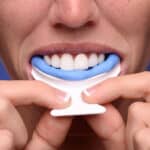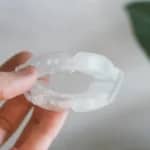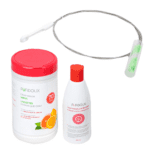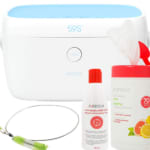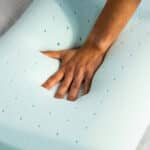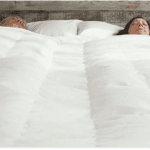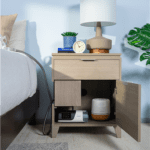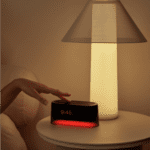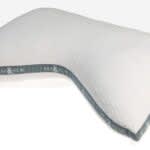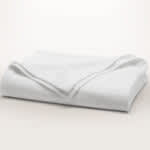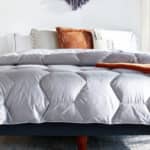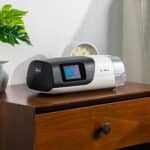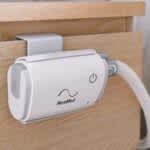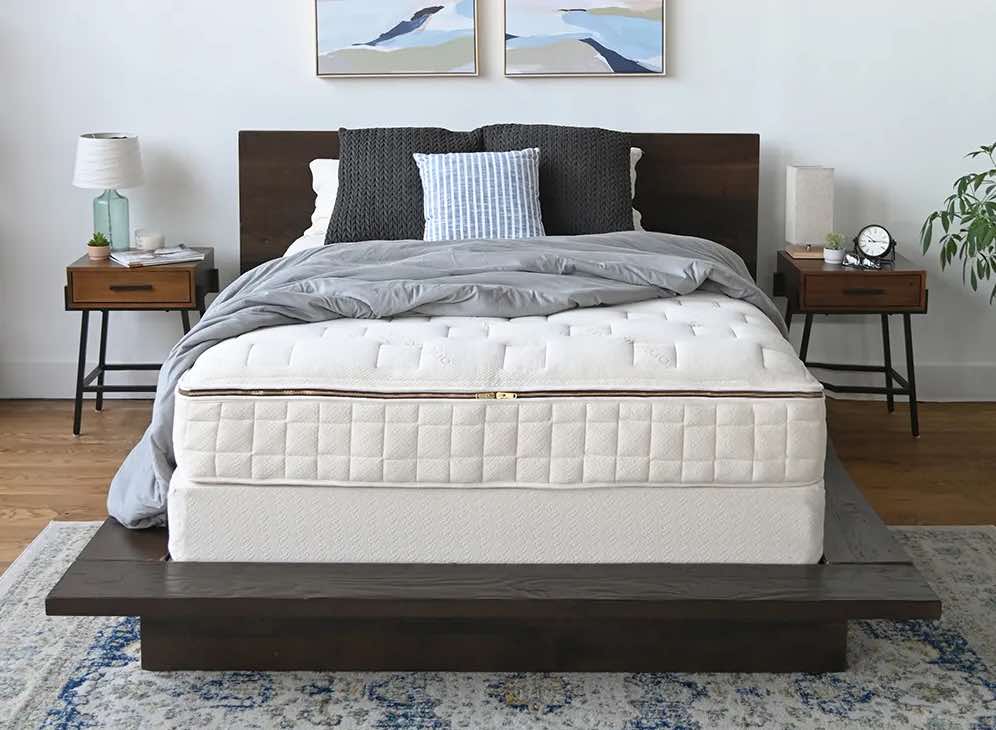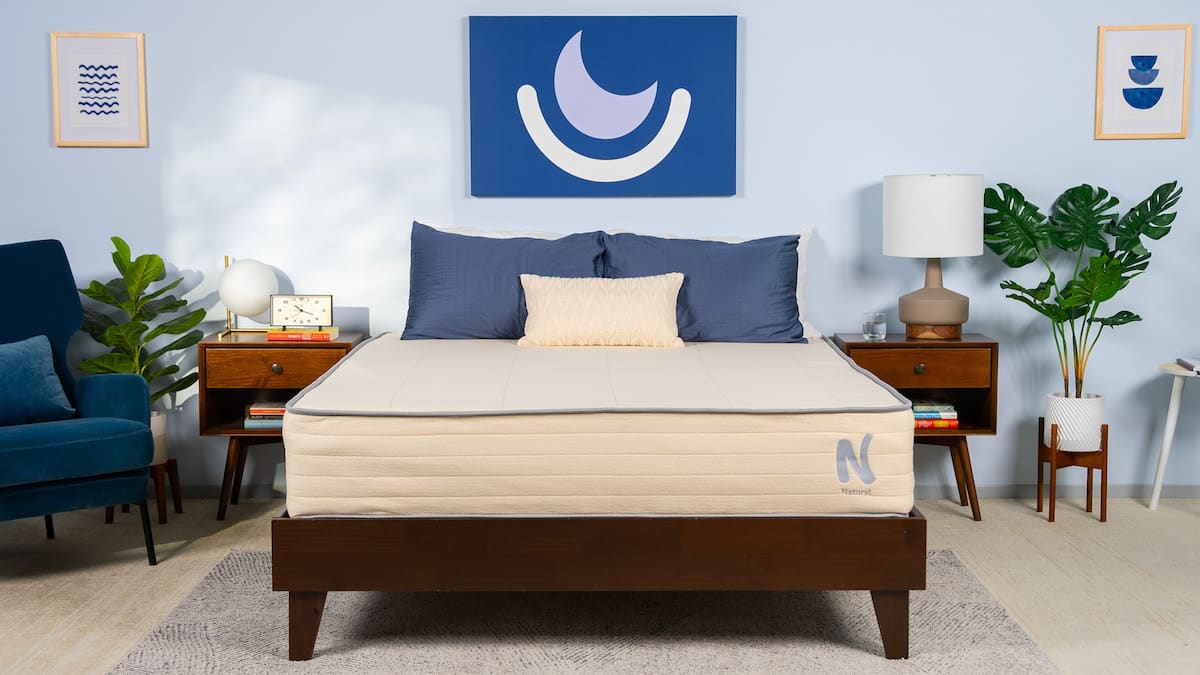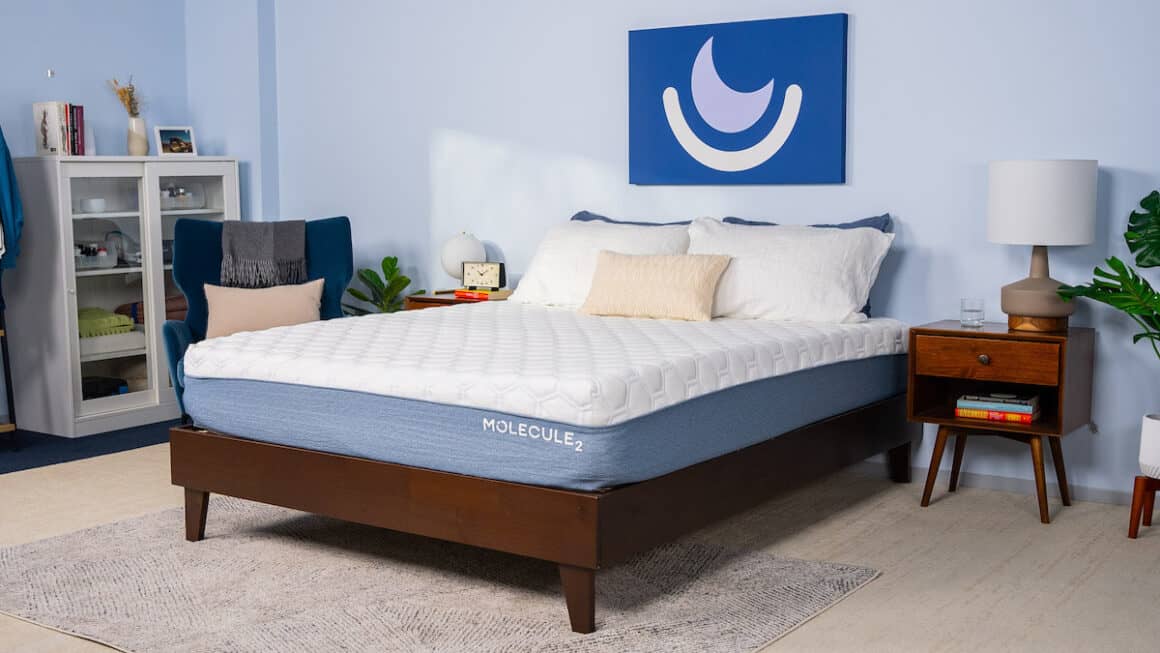Allergy symptoms like nasal congestion and breathing difficulties can impair sleep, often leading to fatigue and diminished performance the next day. Sleepers with allergies may improve their rest by limiting potential triggers in their bedroom environment, including dust, pet dander, mold, and mildew. Finding a mattress that minimizes exposure to common allergens may also help keep allergy symptoms at bay.
Best Mattress for Allergies

Birch Mattress
The Birch Mattress has an eco-conscious design, limiting exposure to common synthetic materials that some sleepers are sensitive to. The latex comfort system also resists common allergens such as mold and dust mites.
We’ll explore some of the best mattresses for allergies. You can also find several allergy-friendly models in our guide to the best mattress of 2025. Sleepers who are sensitive to chemicals and other synthetic materials may want to check out our picks for the best organic mattresses.
Find Your Perfect Mattress
We know mattresses work differently for different types of sleepers. Use the filters below to help narrow down your options for your best bed.
Read on to see why the following five options made our top picks list of 2025’s best mattresses for allergies.
Sleep Doctor’s Picks
Best Overall Mattress
Birch Mattress
The Sleep Doctor’s Review
The Birch Mattress features a latex and coil design topped with cotton and wool layers to cushion your body. All the materials are known for their breathability, so we highly recommend this model for hot sleepers.
Buy From HelixHot Sleepers
Medium Firm (6)
Great Airflow
eco-INSTITUT
Pros
- Breathable construction limits heat buildup and moisture retention that could otherwise fuel microbial growth
- Latex and wool excel at thermoregulation
- Certifications from eco-INSTITUT and GREENGUARD Gold ensure low volatile organic compound (VOC) emissions
Cons
- Not suitable for sleepers sensitive to latex or wool
- Side sleepers under 130 pounds may benefit from a bed with more pressure relief
Why We Like It
Constructed from natural and organic materials, the Birch Mattress is ideal for eco-conscious shoppers with allergies who also tend to sleep hot. Our testers found that the layers of cotton, wool, and latex increased the mattress’ breathability while resisting allergen buildup. The hybrid model merges pocketed coils with Talalay latex for responsive support, and a medium firm (6) feel made the mattress suitable for all of our testers, regardless of weight.
A stretchy and breathable GOTS-certified organic cotton cover encases the mattress. A blend of organic wool and rayon below serves as a natural fire barrier, while an additional wool layer cushions sleepers. Our testing team liked that the layer of natural Talalay latex balanced contouring with responsiveness. The latex is certified by the eco-INSTITUT, indicating that it meets rigorous standards concerning chemical emissions.
How Does It Feel?
We noticed that the pocketed coil core gave the mattress bounce without generating significant motion transfer. The individually wrapped coils promote airflow, which our testers found helped the mattress stay cool. Sturdier coils reinforce the perimeter, providing robust edge support that allowed our testers to use more of the mattress’ surface. A wool-rayon blend layer completes the mattress, acting as an additional flame barrier.
With organic materials and a medium firm (6) feel, the Birch suits a wide range of sleepers looking for a sustainably made mattress designed to minimize allergens.

Most Comfortable Mattress
Naturepedic EOS Classic
The Sleep Doctor’s Review
The Naturepedic EOS Classic is one of the most customizable hybrids we’ve ever tested. The latex and coil model is available in five firmness levels with the option to customize firmness for each side of the bed. We recommend this bed for co-sleepers who have different comfort preferences.
Buy From NaturepedicCouples
Medium Soft (4), Medium (5), Medium Firm (6), Firm (7), Firm (8)
Great Airflow
GREENGUARD, Global Organic Textile Standard (GOTS)
Pros
- Interchangeable layers allow you to customize the feel
- Comes in wool-free and latex-free versions
- GOTS and GREENGUARD Gold certifications ensure organic sourcing and low chemical emissions
Cons
- Wool and latex model is not suitable for sleepers allergic to either material
- Above-average price-point
Why We Like It
The Naturepedic EOS Classic is a latex hybrid mattress with standout customizability features. You can configure the bed into five different firmness options and may also customize different configurations for each side of the bed.
The mattress contains a cotton cover quilted with wool batting and a plant-based PLA material, a 3-inch organic latex layer, an 8-inch layer of pocketed coils, and organic cotton batting. The latex and coil layers each come in different firmness levels and you can place these layers in whichever order feels most comfortable. Depending on which firmness layers you choose and how you order the layers, your firmness options are medium soft (4), medium (5), medium firm (6), firm (7), and firm (8).
How Does It Feel?
Thanks to the excellent customization options, the EOS Classic is suitable for a wide variety of sleep positions and body weights. During testing, stomach sleepers felt most comfortable on firmer configurations. Side sleepers preferred options with more cushioning to help relieve pressure in the shoulders and hips, and back sleepers were most satisfied with medium firm to firm options. Those over 230 pounds felt more comfortable on the firm configurations.
Our tests showed that the EOS Classic sleeps exceptionally cool. This is due in large part to the natural cooling properties of latex and strong ventilation through the coils. The mattress has GREENGUARD certification to ensure low chemical emissions and the latex and cotton are GOLS- and GOTS-certified, respectively, to show that the bed has organic sourcing.
Best Luxury Mattress
Zenhaven
The Sleep Doctor’s Review
The Zenhaven is an all-latex model with a flippable design that provides a different firmness level on each side of the mattress. Most testers on our team found a side that suited their sleep position and personal preferences.
Buy From SaatvaHot Sleepers
Medium Soft (4), Firm (7)
Great Airflow
Global Organic Textile Standard (GOTS)
Pros
- Wool is GOTS-certified and latex is GOLS-certified to guarantee organic sourcing
- Latex and wool provide natural cooling properties
- Dual-sided design offers two firmness levels
Cons
- Not ideal for sleepers with wool or latex allergies
- Produces noticeable motion transfer
Why We Like It
Saatva’s Zenhaven is a natural latex mattress designed to repel everyday allergens like dust mites, mold, and dander. The latex undergoes a special process to remove proteins that typically trigger symptoms. The Zenhaven is also free of harsh chemicals and dyes.
Latex is known to be resilient, and our testing indicated the Zenhaven is a durable mattress. Additionally, our testers noticed the mattress had minimal off-gassing, meaning it doesn’t produce much of the smell commonly associated with memory foam mattresses right after unboxing.
The mattress also has Rainforest Alliance certification, showing that the latex used in its construction was sourced according to strict environmental and social standards.
How Does It Feel
The flippable design offers two different firmness levels: medium soft (4) and firm (7). A GOTS-certified organic cotton cover is designed to draw heat away from your body. The cover is treated with Saatva’s Guardin, a nontoxic treatment intended to reduce microbial growth. A 1-inch layer of organic wool on each side functions as a natural fire barrier.
Both sides use Dunlop latex with small perforations designed to promote airflow. The comfort layers are divided into five zones, which our testers noticed offered targeted support to their backs and midsections. The medium soft side offers deeper contouring, which suited most of our side-sleeping testers. An additional layer of firm Dunlop latex on the reverse side creates a sturdier feel that better suited our back and stomach sleepers.
Best Mattress for Pressure Relief
Nolah Natural 11
The Sleep Doctor’s Review
The Nolah Natural 11’s latex layers and coil core are well-suited to sleepers who need solid support with gentle cradling on the surface. Most testers on our team found this comfortable, regardless of their sleep position.
Buy From NolahHot Sleepers
Medium Firm (6)
Great Airflow
Global Organic Textile Standard (GOTS)
Pros
- Cotton and wool are certified organic
- Latex and wool construction promotes breathability and temperature regulation
- Certifications from GREENGUARD Gold and eco-INSTITUT verify that the mattress meets high standards for VOC emissions
Cons
- Co-sleepers may feel movement when their partner changes positions
- Side sleepers under 130 pounds with sharp pressure points may prefer a mattress with more give
Why We Like It
Blending responsive latex with a pocketed coil core, the Nolah Natural 11 addresses vulnerable pressure points on the spine, hips, and shoulders. The Talalay latex comfort system contours your body while still providing a responsive feel. With an 11-inch profile and a balanced medium firm (6) feel, the hybrid mattress performed well for all of our testers regardless of body size or sleep position.
The mattress is topped with breathable layers of GOTS-certified organic wool and cotton. This means that an official body has reviewed the supply chain to make sure the process is actually organic, according to professional standards. The mattress also has Rainforest Alliance certifications, indicating that it meets strict content and environmental guidelines.
How Does It Feel?
Our testers reported that the 2-inch layer of natural Talalay latex conformed to their bodies, providing standout pressure relief. A 1-inch layer of transitional Talalay latex supported spinal alignment, helping to prevent aches and pains.
Nolah’s HDMax Tri-Zone coiled core is zoned, which gave our testers targeted support and minimized sinkage. The coils are individually wrapped and lined with cotton and wool to increase breathability.
With excellent pressure-relieving abilities and a medium firm (6) feel, the Nolah Mattress suits a wide range of sleepers looking for a foam bed that contours to the body and sleeps cool. Its certified materials also make it less likely to collect allergens and exacerbate allergy symptoms.
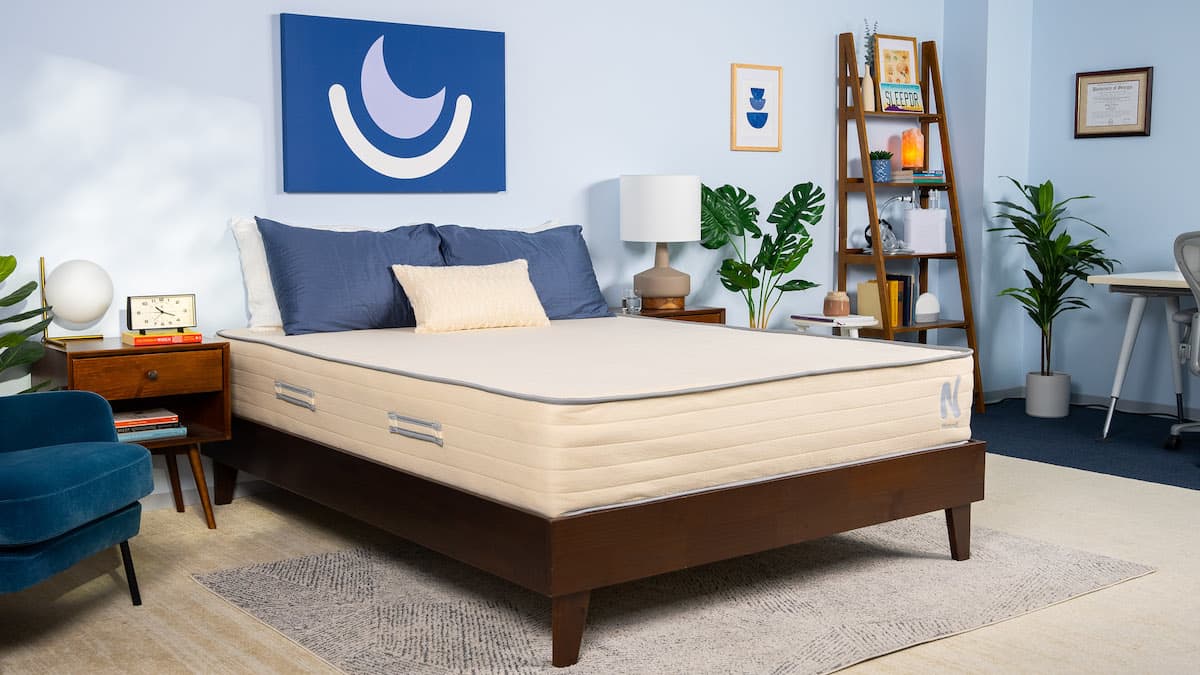
Best Cooling Mattress
Molecule 2 AirTEC Mattress
The Sleep Doctor’s Review
The all-foam design of the Molecule 2 AirTEC Mattress caters to sleepers who need strong cushioning for sensitive joints. The bed earned the highest marks from our side-sleeping testers, who enjoy beds that cradle the shoulders and hips.
Buy From MolelculeCombination Sleepers
Medium Firm (6)
Some Airflow
CertiPUR-US
Pros
- Specialized open-cell polyfoam is intended to allow more airflow than traditional foam
- Transitional layer is zoned to reinforce the midsection and cradle lighter areas of the body
- Cover fabric contains an antimicrobial treatment designed to combat mold, mildew, and other potential contaminants
Cons
- Foam may produce off-gassing odors at first
- Thick polyfoam layers may inhibit movement
Why We Like It
The Molecule 2 AirTEC is equipped with cooling features that set the mattress apart from other all-foam models, many of which trap and store heat to a bothersome degree. The topmost foam layer is infused with crystals intended to dissipate body heat from the surface. We noticed that the cover, made from a breathable poly-spandex blend, worked well with the ventilated comfort layer and convoluted transitional layer to promote airflow throughout the interior of the mattress. This helped keep our testers cool.
For hot sleepers who find it difficult to sleep comfortably on other all-foam mattresses, the Molecule 2 AirTEC provides a supportive sleep surface that includes technologies designed to prevent allergen and bacterial buildup.

How Does It Feel?
The Molecule 2 AirTEC’s medium firm (6) feel ensured light cushioning and even support for most of our side and back sleepers. During our tests, the mattress felt most comfortable to side sleepers weighing more than 130 pounds and back sleepers weighing up to 230 pounds.
The transitional layer is zoned to feel firmer beneath the torso and hips, and gentler around the head, shoulders, and legs. This feature allowed our side-sleeping testers to lie comfortably without feeling too much pressure in the shoulders and hips, while our back-sleeping testers noticed minimal sinkage around their midsections.
All Molecule 2 AirTEC models are given a Microban treatment during production. This antimicrobial agent is engineered to minimize growth of bacteria, mold, mildew, and other contaminants that can trigger allergy symptoms and make your sleep surface less hygienic.
Compare Our Top Picks
| Birch Mattress | Naturepedic EOS Classic | Zenhaven | Nolah Natural 11 | Molecule 2 AirTEC Mattress | |
|---|---|---|---|---|---|
| Mattress Type | Hybrid | Hybrid | Latex | Hybrid | Foam |
| Firmness | Medium Firm (6) | Medium Soft (4), Medium (5), Medium Firm (6), Firm (7), Firm (8) | Medium Soft (4), Firm (7) | Medium Firm (6) | Medium Firm (6) |
| Ideal For | Hot Sleepers | Couples | Hot Sleepers | Hot Sleepers | Combination Sleepers |
| Temperature Control | Very Good | Good | Very Good | Excellent | Good |
| Pressure Relief | Good | Very Good | Very Good | Good | Very Good |
| Sleep Trial | 100 nights (30-night requirement) | 100 nights (30-night requirement) | 365 nights ($99 return fee) | 120 nights | 100 nights (30-night requirement) |
Benefits of a Hypoallergenic Mattress
Sleeping with allergies is often a challenge. Common symptoms, such as nasal congestion, are associated with poor sleep quality, which may then impact your productivity and quality of life the following day. A hypoallergenic mattress can help limit allergens in the bedroom environment, potentially reducing symptoms for sleepers with allergies.
Even sleepers without allergies may prefer to reduce their exposure to dust mites, mold, mildew, pollen, and other contaminants. Individuals with sensitive skin, asthma, or other respiratory issues may benefit from a hypoallergenic sleep surface that limits exposure to these irritants. Additionally, some parents prefer a hypoallergenic mattress for their children in order to maintain a more hygienic sleeping area.
What Is the Best Mattress Type for Allergies?
Depending on the nature and severity of your allergy symptoms, any of the most common mattress types may be appropriate for you. While some mattresses tend to be better suited to sleepers with allergies than others, individual models vary significantly. We recommend paying attention to materials, construction, and overall quality to choose what’s best for you.
| Mattress Type | Description | Considerations |
|---|---|---|
| Foam | Foam mattresses are made with polyfoam or memory foam that closely molds to the sleeper’s body. These models typically offer significant pressure relief and motion isolation. | Memory foam and high-density polyfoam may be less susceptible to dust mites and other allergens, but off-gassing odors could be a challenge for those with chemical sensitivities. |
| Latex | Latex mattresses contain layers of natural, synthetic, or blended latex, though most use natural latex. This type of mattress is known for its responsiveness, temperature control, and durability. | Latex is naturally hypoallergenic when it comes to allergens like mold, mildew, and dust mites, but some sleepers may be allergic to the latex itself. Also, the surface may feel too bouncy for those who share the bed with a restless sleeper. |
| Hybrid/Innerspring | An innerspring mattress consists primarily of a coil core with little padding on the surface, whereas a hybrid model pairs a thicker foam or latex comfort system with a coil core. These designs tend to be breathable and responsive. | Hypoallergenic comfort systems can limit allergen exposure, and some designs feature covers with antimicrobial treatments, but coil systems or fiber padding could potentially harbor allergens. |
| Airbed | Airbeds typically combine a foam or latex comfort system with an air chamber core. You can adjust the firmness by filling or emptying the air chambers. | The price-point is typically higher than other mattress types, but air chambers are luckily not conducive to allergens and the comfort systems are frequently made with hypoallergenic materials. |
Video: Is a Latex Mattress Right for You?
Watch our video to learn more about whether a latex mattress is best for you and what to consider when shopping for one.
How to Make Your Bed Allergy-Friendly
Irritants or allergens in your bedding or mattress can contribute to uncomfortable allergy symptoms. Whether these symptoms are caused by dust mites, sleeping with a pet, or other allergens, making your bed more allergy-friendly could help you get a better night’s sleep.
Buy the Right Bedding
In addition to selecting a hypoallergenic mattress, try to find allergy-friendly bedding. Allergens can build up in your sheets, blankets, pillows, and other bedding materials, so look for options that are easy to clean and designed to resist allergens.
- Sheets and Blankets: Smooth, tightly woven fabrics tend to be less prone to allergen buildup. Many sleepers with allergies prefer breathable, natural materials, such as cotton, wool, and silk. Air circulation can help reduce the risk of mold or mildew, while natural materials generally contain fewer chemicals and dyes that sleepers might be sensitive to.
- Pillows: Memory foam and latex pillows are usually among the top options for sleepers with allergies. Down and feather options often trap moisture, potentially promoting allergy-inducing mold growth. Additionally, pillows with loose fiber fill may harbor dust mites.
Clean Your Bed Regularly
Cleaning your bed environment helps remove allergens from your sleep space. We suggest washing your sheets weekly to reduce the allergens you’re in contact with. You can also clean your mattress by stripping it and vacuuming the surface with an upholstery attachment. We generally recommend doing this every six months, though individuals with allergies may prefer to do it more often.
A mattress protector can also provide an extra barrier between you and your mattress. If allergens have already accumulated in your bed, a mattress protector could limit your exposure. If your mattress is new, a protector can help prevent allergen buildup that might otherwise shorten its lifespan.
Additional Tips for Sleeping Soundly With Allergies
In addition to buying the right mattress and bedding and keeping them clean, people with allergies can take other steps to get better rest.
- Use an air purifier: A high-quality air filtration system helps remove airborne particles.
- Avoid sleeping with pets: Pet dander can trigger allergy symptoms for some sleepers, so sleeping with pets in the bed might exacerbate allergies and may also track other allergens into your bedroom.
- Shower before bed: Dust and pollen may linger on your skin and hair. Showering before you go to sleep reduces the amount of allergens you bring into your bed.
- Clean your bedroom regularly: Vacuuming, dusting, and regularly cleaning any fabrics and surfaces in your bedroom can reduce allergen buildup.
- Limit outdoor allergens: Leave your windows closed and keep any clothing that you’ve worn outdoors away from your bed.
- Consult your doctor: Discuss your allergy symptoms with a medical professional to investigate the potential causes. Your doctor may recommend a course of action to help you get better sleep.
Discover More Mattress Solutions
If you’ve narrowed down the type of mattress you want but need more options, check out our testing team’s picks below.
How We Test
We rely on extensive lab-based product testing to help you choose the right mattress. Our testers vary in body type and sleep position to ensure our mattress evaluations are inclusive of many different sleepers. Before choosing our picks for the best mattresses for allergies, we tested dozens of top contenders using our product testing methodology and assessed their materials and performance.
Frequently Asked Questions
The best mattress for allergies typically contains hypoallergenic materials and resists mold, mildew, dust mites, and other allergens. Many sleepers with allergies also prefer natural materials to limit their exposure to chemicals that could cause irritation.
Many sleepers with allergies prefer to lie on their side or on their back with their head propped up. Sleeping on your side can help keep your airway open, and elevating your upper body with extra pillows or a wedge pillow often helps alleviate congestion and postnasal drip.
If your allergy symptoms are more severe overnight or when you first wake up, your bed might be making your allergies worse. You can try laundering your bedding and cleaning your bedroom to see if your symptoms improve. If not, it may be time to consider a new mattress.
The best bedding for allergies is made with breathable, hypoallergenic materials that are easy to clean. Tightly woven fabrics and natural materials, such as cotton, wool, linen, and silk, may be beneficial for sleepers who have allergies. Since regular laundering is critical for removing allergens, ease of care may be just as high of a priority.
You can protect your mattress from allergens by selecting a model made with hypoallergenic materials, cleaning it periodically, washing your bedding regularly, maintaining a clean bedroom, and using a mattress protector. While some allergens may still accumulate on or in your mattress over time, regular care and maintenance can help reduce buildup and extend the mattress’ lifespan.



